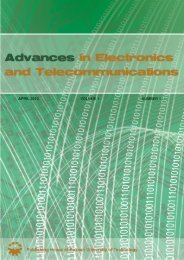november 2010 volume 1 number 2 - Advances in Electronics and ...
november 2010 volume 1 number 2 - Advances in Electronics and ...
november 2010 volume 1 number 2 - Advances in Electronics and ...
You also want an ePaper? Increase the reach of your titles
YUMPU automatically turns print PDFs into web optimized ePapers that Google loves.
30 ADVANCES IN ELECTRONICS AND TELECOMMUNICATIONS, VOL. 1, NO. 2, NOVEMBER <strong>2010</strong><br />
Simulation model for evaluation of packet sequence<br />
changed order of stream <strong>in</strong> DiffServ network<br />
M. Czarkowski <strong>and</strong> S. Kaczmarek<br />
Abstract—Current packet networks use a large variety of<br />
mechanisms which should support QoS (Quality of Service). One<br />
of those mechanisms is rout<strong>in</strong>g (calculat<strong>in</strong>g connection paths for<br />
<strong>in</strong>com<strong>in</strong>g service requests). The most effective mechanism <strong>in</strong> QoS<br />
context is dynamic rout<strong>in</strong>g, based on the current network state<br />
described by the offered traffic matrix <strong>and</strong> l<strong>in</strong>k states. After<br />
switch<strong>in</strong>g between calculated available paths, connection path<br />
changes may cause received packets to change order with<strong>in</strong> a<br />
s<strong>in</strong>gle stream. This paper <strong>in</strong>cludes the problem def<strong>in</strong>ition <strong>and</strong> the<br />
analysis of all additional effects. A comb<strong>in</strong>ed simulation/analytic<br />
model was proposed <strong>in</strong> order to answer whether the <strong>number</strong> of<br />
changed-orderpackets issignificant<strong>and</strong>ifitshouldbeconsidered<br />
when calculat<strong>in</strong>g the end-to-end delay balance <strong>in</strong> analytical models<br />
for packet networks withdifferentiatedservices. Furthermore,<br />
the proposed model gave the answer on how often calculated<br />
paths may be switched to avoid the network be<strong>in</strong>gout of tune.<br />
Index Terms—IP, QoS, DiffServ, QoS rout<strong>in</strong>g<br />
I. INTRODUCTION<br />
CURRENT telecommunications networks are based on a<br />
largevarietyoftechnologies.Manyofthosenetworksare<br />
packet based networks with focus on networks which use IP<br />
protocol (so called IP networks). If they are applied <strong>in</strong> a local<br />
scope (IP network connect<strong>in</strong>g just neighbor devices), they<br />
work accord<strong>in</strong>g to the provided design <strong>and</strong> they do not cause<br />
any additional problems with configuration <strong>and</strong> ma<strong>in</strong>tenance;<br />
however, when they are used <strong>in</strong> a global scope (IP network<br />
as a core network), they are the source of many problems<br />
<strong>and</strong> unexpected network behavior. Those problems are mostly<br />
comb<strong>in</strong>ed with servic<strong>in</strong>g requested QoS <strong>and</strong>, simultaneously,<br />
optimal network resources utilization. It is due to very strong<br />
dynamic traffic changes from multiple traffic sources. Those<br />
sources vary <strong>in</strong> their traffic characteristics. That is why any<br />
mechanism used should be resistant to such strong traffic<br />
dynamics. Unfortunately,current network control mechanisms<br />
provided for IP networks fail to solve this problem [1],<br />
[2]. One of network control mechanisms is connection path<br />
calculation process – rout<strong>in</strong>g. The important condition which<br />
should provide effective rout<strong>in</strong>g <strong>in</strong> these terms is to calculate<br />
paths to support requested QoS for differentiated services.<br />
Effective path calculation means also avoid<strong>in</strong>g network congestion<br />
states <strong>and</strong> optimization of available resources. Current<br />
rout<strong>in</strong>g mechanisms do not meet those requirements [3], [4].<br />
The key element to solve this problem is to use dynamic<br />
M. Czarkowski is with the Gdansk University of Technology, Faculty<br />
<strong>Electronics</strong>, Telecommunications <strong>and</strong> Informatics, Gdansk, Pol<strong>and</strong> (e-mail:<br />
czarka@eti.pg.gda.pl).<br />
S. Kaczmarek is with the Gdansk University of Technology, Faculty<br />
<strong>Electronics</strong>, Telecommunications <strong>and</strong> Informatics, Gdansk, Pol<strong>and</strong> (e-mail:<br />
kasyl@eti.pg.gda.pl).<br />
This work was supported <strong>in</strong> part by the Polish National Centre for Research<br />
<strong>and</strong> Development under the project PBZ MNiSW – 02/II/2007.<br />
rout<strong>in</strong>g – the process of path calculation which follows the<br />
network changes <strong>and</strong> path selection decision, based solely<br />
on the current network state. In addition, the <strong>in</strong>troduction of<br />
dynamic rout<strong>in</strong>g causes some consequences. One of them are<br />
<strong>in</strong>com<strong>in</strong>g packets order changes with<strong>in</strong> a s<strong>in</strong>gle stream, which<br />
is due to the switch<strong>in</strong>g of available paths. Change of packets<br />
order is caused by switch<strong>in</strong>g from a path with longer delay<br />
<strong>in</strong>to a path with shorter delay. The packet delay is directly<br />
comb<strong>in</strong>edwiththe<strong>number</strong>oftransitnodes<strong>and</strong>trafficcurrently<br />
located <strong>in</strong> the network. Unfortunately, there is no scientific<br />
literature which considers the problem <strong>and</strong> no research results<br />
on the subject of reordered packets. Most authors deal<strong>in</strong>g<br />
with dynamic rout<strong>in</strong>g mechanisms assume <strong>in</strong> their works that<br />
packet reorder<strong>in</strong>gdur<strong>in</strong>g path switch<strong>in</strong>g is not significant. The<br />
authors who noticed the problem of packet reorder<strong>in</strong>g made<br />
<strong>in</strong>itial assumption that reorder<strong>in</strong>g will be solved by upper<br />
layers <strong>and</strong> they just shift the responsibility. Other analyzed<br />
papers <strong>in</strong>cluded the assumption that packet reorder<strong>in</strong>g due to<br />
path switch<strong>in</strong>g will not be considered because it is not an<br />
important issue. It seems to be a wrong assumption. In this<br />
paper we give the answer to the question whether the packet<br />
sequencechangedorderisasignificanteffectfromthe po<strong>in</strong>tof<br />
view of dynamic rout<strong>in</strong>g. The rest of the paper is organizedas<br />
specified below. Section II describes the problem <strong>in</strong> general<br />
<strong>in</strong> terms of generated traffic relations <strong>and</strong> available system<br />
resources. Section III is a short description of the proposed<br />
simulation model used for problem evaluation <strong>and</strong> extended<br />
experiments. Section IV conta<strong>in</strong>s the research results <strong>and</strong> the<br />
analysis of those results. Some <strong>in</strong>vestigated relations are also<br />
identified. The f<strong>in</strong>al section V provides a short summary with<br />
focus on further work directions.<br />
II. PROBLEM DEFINITION AND DECOMPOSITION<br />
Some basic assumptions were made for further <strong>in</strong>vestigations.<br />
The analyzed network supports prioritized services.<br />
Packetscome<strong>in</strong>to/comeoutofthenetworkviaedgenodes.All<br />
core nodes support transit nodes functionality. Additionally,<br />
the service <strong>in</strong> the node is based on the non-preemptivepriority<br />
model. The considered problem is illustrated <strong>in</strong> Fig. 1.<br />
Packets come <strong>in</strong>to the network <strong>in</strong>to edge node A <strong>and</strong> are<br />
transferredviacorenodeCtoedgenodeB.Thefirstcalculated<br />
path1 from node A to node B is A→C→B. All packets<br />
with dest<strong>in</strong>ation address B are transported us<strong>in</strong>g this path.<br />
After sudden traffic changes on path1, congestion state has<br />
been detected <strong>and</strong> the entire path had to be calculated aga<strong>in</strong><br />
(dynamicrout<strong>in</strong>g).Letusassumethatthenewcalculatedpath2<br />
fromAtoBis:A→D→E→C→B.Packetssentbeforethepath<br />
recalculation, which were be<strong>in</strong>g transported via path1 (<strong>and</strong>







